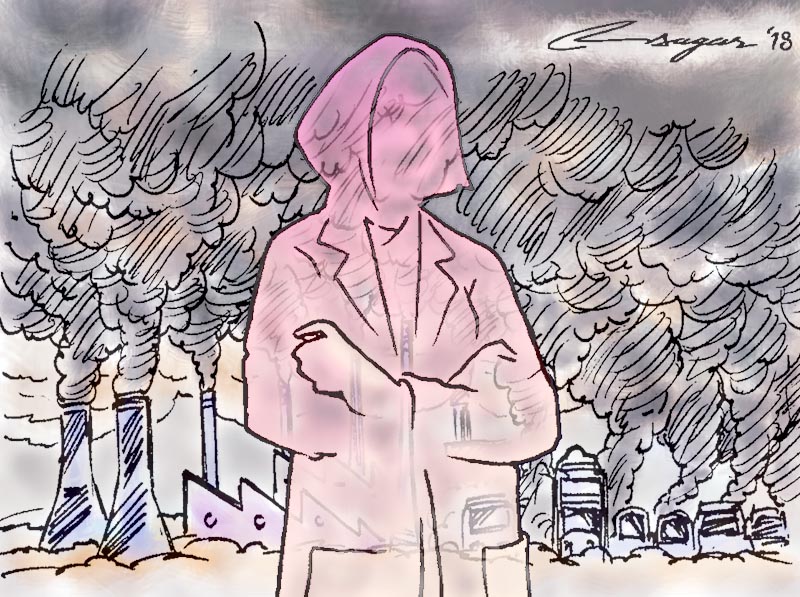Rising air pollution: Effects on mental health
The effect of air pollution on our lungs and our physical health is self-evident, but is the mental effect just as obvious? There is ample analysis on pollution leading to mental problems indirectly
Each day, armed with our masks and scarves, we head out onto the battlefield, where the enemies are not fellow humans but tiny dust and smoke particles, almost invisible to the naked eye except when they are present in hordes. And oh, aren’t they present in hordes. Particulate matters of widths less than 2.5 microns (PM2.5) are the especially insidious enemies that enter our lungs unimpeded by all the physical barriers set up by our body such as nose hair and mucus. According to the World Health Organisation, 4.2 million deaths worldwide every year are attributed to ambient air pollution.
But we don’t really need all that science and air quality monitors and sensors to tell the local inhabitants of the Kathmandu Valley how polluted this place is. Especially those of us with asthma and bronchitis and other breathing ailments, we don’t even need to leave the house to feel suffocated and ill.
Even people who could afford to work from home, staying locked up inside of their soundproof houses using the best water filters or drive with all the windows rolled up are not safe. Because these adversaries can go anywhere unobstructed, flying in through cracks in door hinges, through window mesh, and even briefly opened entrances. So, with the ever-growing rate of road and building construction and the ruins from the 2015 earthquake still lying around, it does not look like the air is going to get any cleaner any time soon. The effect of this on our lungs and our physical health is self-evident, but is the mental effect just as obvious? Is anybody looking at that?
There’s no research so far on how toxins in the air could be altering brain chemistry and directly leading to mental illness. But there is ample analysis on pollution leading to mental problems indirectly. Breathing techniques are often mentioned as one of the most effective stress management tools that everyone has access to. But how many of these techniques involve holding one’s breath or breathing in short gasps through a piece of fabric to avoid breathing in car exhaust? Research indicates that our breathing rates and whether we breathe from the chest or the diaphragm (diaphragm-breathing is shown to be more calming) are some of the various ways breathing can affect our stress and anxiety levels which impact our mental wellbeing. And health concerns, worsened by our constant exposure to unclean air, lead to their own sets of anxieties.
Mental health benefits of being around nature have also been well-documented. It’s clear that being in a greener (and cleaner—because plants don’t do very well in polluted areas, naturally) and spacious environment leads to elevation in mood and general happiness. But our valley is hardly a place one could call green, except during the rainy months, when the plants are able to flourish using the abundant water and sunlight, and the water repeatedly washes away the dark soot and grey dust that otherwise settle permanently on the leaves. The Valley’s perpetual lack of parks and open spaces (which had been so starkly clear to us during the 2015 earthquakes, but, seeing the upswing in building constructions again, we seem to have forgotten all too soon) further proves this. Exercise is always on the first line of defence against psychological stressors. But, for nine-to-fiver Kathmanduites, the only time for a walk or a run is early morning—and as scientists have pointed out, the air is the most toxic then, what with all the fumes of the day before having settled down exactly at human height.
Then there is an even more uncomfortable topic: unethical behaviour. Research has shown that pollution can increase anxiety and that anxiety is related to unethical behaviour. One such study involved an experiment in which the participants were shown pictures of either polluted or unpolluted cities and told to imagine living there. After that, in a supposedly unrelated word association task that they had to complete on a computer, the participants found out that due to software glitch they could cheat to score higher. Results showed that significantly more participants who had been exposed to pictures of pollution cheated than those who had looked at pictures of unpolluted cityscapes.
So how do we keep all the people living in this dust bowl physically healthy, mentally happy, and ethically sound? And while it’s tempting to point our finger at others (maybe even justifiably so), it would be more constructive to focus instead on the fingers that we end up pointing at ourselves. Joint effort at making small changes to our behaviour could lead to significant positive changes around.
Could the physically able ones among us walk or cycle to work instead of ride or drive? Or use public transport, especially the electric ones? Could we look for houses already built to live in, not drive in age-old vehicles, increase pressure on the government to speed up road construction and not leave it lying half- or poorly-constructed, set up laws to decrease building construction time by limiting the number of stories allowed, make a collective endeavour to plant as many trees around the valley as possible? Of course, solutions, as always, are easy to see but difficult to implement. But they are now more necessary than ever. So it’s time to end this daily war once and for all—not only for the sake of being cleaner on the outside, but also happier on the inside.
Shivakoti is a graduate in psychology






